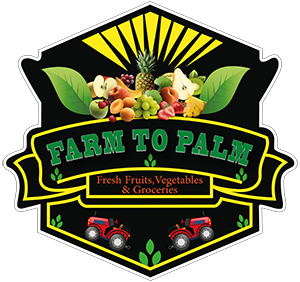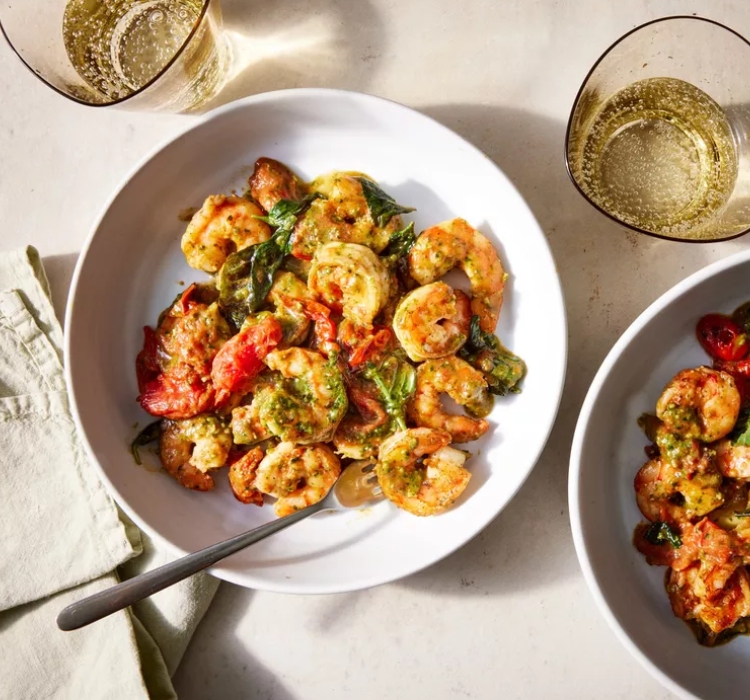This versatile and quick pesto shrimp can be served in various ways: alongside a hunk of crusty bread, over pasta or rice, or even used as a topping for pizza.
Look for shrimp free from preservatives, as they can alter the texture and add sodium to the dish.
We recommend refrigerated pesto for its brightness and fresh flavor, but a homemade classic basil pesto will make the dish extra special.
- Active Time: 15 mins
- Total Time: 15 mins
- Servings: 4
Nutrition Notes:
Is Shrimp Good for You?
While shrimp is high in cholesterol, research suggests that it’s not necessarily the cholesterol in our foods that increases our bodies’ cholesterol. It’s the trans fats and saturated fats that do.
Shrimp is an excellent protein source of vitamin B12, choline, phosphorus, selenium, zinc, and iodine. It has almost no saturated fat, and its fats are heart-healthy omega-3s.
Shrimp also contains the antioxidant astaxanthin.
Is Pesto Healthy?
Yes! Pesto is a delicious combination of healthy ingredients.
While you will find different varieties of pesto, it is traditionally made with olive oil, basil, garlic, pine nuts, and Parmesan cheese.
Is This Recipe Gluten-Free?
Yes, this recipe is gluten-free. However, it’s always wise to read the label on prepared items like Italian seasoning and pesto to ensure they haven’t snuck any gluten-containing ingredients into them.
Tips from the Test Kitchen:
Can I Use Frozen Shrimp?
Yes, but make sure to thaw the shrimp before cooking. Thaw frozen shrimp in the refrigerator a day before making the recipe. To melt quickly, place frozen shrimp in a large bowl with ice water for 20 minutes. Once the shrimp is thawed, pat dry with paper towels to remove excess moisture.
I Need To Have No-Salt-Added Italian Seasoning, What Can I Use Instead?
You can blend your Italian seasoning with dried herbs from your pantry, such as oregano, basil, thyme, sage, and rosemary.
How to Serve Pesto Shrimp:
Serve over pasta, brown rice, cauliflower rice, or quinoa.
Make pesto shrimp grain bowls for healthy lunches or dinners.
It’s delicious as a topping for pizza, using store-bought or homemade pizza dough.
Serve with crusty bread and a side salad for a quick and easy meal.
Frequently Asked Questions:
What Is Pesto Made Of?
Pesto is a vibrant green sauce traditionally made with fresh basil leaves, garlic, pine nuts, Parmigiano-Reggiano cheese, and olive oil.
Is Pesto a Hot or Cold Sauce?
Pesto is a no-cook sauce served cold, at room temperature, or warm. Adding pesto after removing the container from heat is best to retain its fresh flavor in cooked dishes.
Additional reporting by Carrie Myers and Jan Valdez
Ingredients:
- 2 tablespoons extra-virgin olive oil, divided
- 1 ½ pounds large peeled, deveined raw shrimp
- 1 teaspoon no-salt-added Italian seasoning
- 1 pint grape tomatoes
- 2 cups loosely packed fresh basil leaves
- ½ cup refrigerated basil pesto
Directions:
- Heat 1 tablespoon oil in a large nonstick skillet over medium-high heat.
- Add shrimp and Italian seasoning; cook, often stirring, until the shrimp are just cooked through and turn opaque, 3 to 5 minutes.
- Transfer the shrimp to a plate. Wipe the pan clean.
- Add one tablespoon of oil to the pan; heat over medium heat.
- Add tomatoes; cook, stirring occasionally, and press the tomatoes down lightly with tongs or a wooden spoon until the tomatoes begin to break down and juices are released about 5 minutes.
- Add basil and return the shrimp to the pan.
- Cook, stirring constantly, until the basil is wilted and the shrimp are warm about 1 minute.
- Remove from heat; stir in pesto.
Nutrition Facts (per serving)
- Servings Per Recipe: 4
- Serving Size: 1 cup
- Calories: 330
- Total Carbohydrate: 8g (3% DV)
- Dietary Fiber: 1g (4% DV)
- Total Sugars: 4g
- Protein: 27g (54% DV)
- Total Fat: 22g (28% DV)
- Saturated Fat: 4g (20% DV)
- Cholesterol: 222mg (74% DV)
- Vitamins:
- Vitamin A: 1366IU (27% DV)
- Vitamin C: 11mg (12% DV)
- Vitamin D: 5IU (1% DV)
- Vitamin E: 3mg (22% DV)
- Folate: 47mcg (12% DV)
- Vitamin K: 29mcg (24% DV)
- Minerals:
- Sodium: 446mg (19% DV)
- Calcium: 207mg (16% DV)
- Iron: 1mg (6% DV)
- Magnesium: 49mg (12% DV)
- Potassium: 392mg (8% DV)
- Zinc: 2mg (18% DV)
- Vitamin B12: 2mcg (83% DV)
Note: Nutrition information is calculated by a registered dietitian using an ingredient database but should be considered an estimate.
- Daily Values (DVs) are the recommended amounts of daily nutrients consumed.
- Percent Daily Value (%DV) found on nutrition labels tells you how much a serving of a particular food or recipe contributes to each of those total recommended amounts.
- The daily value is based on a standard 2,000-calorie diet, per the Food and Drug Administration (FDA).
- You may need more or less particular nutrients depending on your calorie needs or health condition.
- If you are following a special diet for medical reasons, consult with your primary care provider or a registered dietitian to better understand your nutrition needs. Information may not be currently available for certain nutrients.

